Android and iOS, the number one and number two ranked smartphone operating systems (OS) worldwide, combined for 91.1% of all smartphone shipments during the fourth quarter of 2012 (4Q12). According to the International Data Corporation (IDC) Worldwide Quarterly Mobile Phone Tracker, Android smartphone vendors and Apple shipped a total of 207.6 million units worldwide during 4Q12, up 70.2% from the 122.0 million units shipped during 4Q11. For calendar year 2012, Android and iOS combined for 87.6% of the 722.4 million smartphones shipped worldwide, up from 68.1% of the 494.5 million units shipped during calendar year 2011.
“The dominance of Android and Apple reached a new watermark in the fourth quarter,” said Ramon Llamas, research manager with IDC’s Mobile Phone team. “Android boasted a broad selection of smartphones, and an equally deep list of smartphone vendor partners. Finding an Android smartphone for nearly any budget, taste, size, and price was all but guaranteed during 2012. As a result, Android was rewarded with market-beating growth.”
“Likewise, demand for Apple’s iPhone 5 kept iOS out in front and in the hands of many smartphone users,” added Llamas. “At the same time, lower prices on the iPhone 4 and the iPhone 4S brought iOS within reach of more users and sustained volume success of older models. Even with the Apple Maps debacle, iPhone owners were not deterred from purchasing new iPhones.”
Smartphone Operating System Highlights
Android continued its overall upward trajectory, reaching triple-digit growth for the year. Samsung was the biggest contributor to Android’s success, amassing 42.0% of all Android smartphone shipments during the year. Following Samsung was a long list of vendors with single digit market share, and an even longer list of vendors with market share less than one percent. The intra-Android competition has not stifled companies from keeping Android as the cornerstone of their respective smartphone strategies, but has upped the ante to innovate proprietary experiences.
iOS posted yet another quarter and year of double-digit growth with strong demand for the iPhone. But what also stands out is how iOS’s year-over-year growth has slowed compared to the overall market. The smaller volumes during 2Q12 and to a smaller extent 3Q12 underscore the possibility for a mid-year iPhone release in order to maintain market-beating growth. Speculation about the release of possible larger-screen and inexpensive models during the middle of 2013 continues to follow Apple, which would help sustain growth. But until any model is formally announced, speculation remains simply that.
BlackBerry‘s decision to postpone the release of BB10 to 2013 left the platform vulnerable in 2012 and reliant primarily on older smartphones running on BB7. As a result, BlackBerry’s tight grip on enterprise users has loosened and its popularity within emerging markets has been diminished by the competition. Now that BlackBerry has unveiled BB10, the company is faced with migrating current BlackBerry users to upgrade while persuading smartphone users of other platforms, including previous BlackBerry users, to switch.
Windows Phone/Windows Mobile made market-beating progress in 4Q12 and 2012. The addition of Nokia’s strong commitment behind the platform was the key driver in Microsoft’s success. At the same time, the relationship has benefited Nokia, which amassed 76.0% of all Windows Phone/Windows Mobile smartphone shipments. Beyond Nokia, however, is a short list of other vendors who have been experimenting with Windows Phone while also supporting Android.
Linux has remained essentially flat from the previous year, with longtime supporters NEC and Panasonic moving to Android and newcomers K-Touch and Haier making up the difference. Linux will bear close observation in 2013 as new smartphones from SailFish, Tizen, and Ubuntu are all scheduled to launch this year. Still, these new Linux-powered operating systems will require time and investment to gain momentum in the market, making for a slowly growing trajectory.
Top Five Smartphone Operating Systems, Shipments, and Market Share, 4Q12 (Units in Millions)
|
Operating System |
4Q12 Unit Shipments |
4Q12 Market Share |
4Q11 Unit Shipments |
4Q11 Market Share |
Year over Year Change |
| Android |
159.8 |
70.1% |
85.0 |
52.9% |
88.0% |
| iOS |
47.8 |
21.0% |
37.0 |
23.0% |
29.2% |
| BlackBerry |
7.4 |
3.2% |
13.0 |
8.1% |
-43.1% |
| Windows Phone/ Windows Mobile |
6.0 |
2.6% |
2.4 |
1.5% |
150.0% |
| Linux |
3.8 |
1.7% |
3.9 |
2.4% |
-2.6% |
| Others |
3.0 |
1.3% |
19.5 |
12.1% |
-84.6% |
| Total |
227.8 |
100.0% |
160.8 |
100.0% |
41.7% |
Top Five Smartphone Operating Systems, Shipments, and Market Share, 2012 (Units in Millions)
|
Operating System |
2012 Unit Shipments |
2012 Market Share |
2011 Unit Shipments |
2011 Market Share |
Year over Year Change |
| Android |
497.1 |
68.8% |
243.5 |
49.2% |
104.1% |
| iOS |
135.9 |
18.8% |
93.1 |
18.8% |
46.0% |
| BlackBerry |
32.5 |
4.5% |
51.1 |
10.3% |
-36.4% |
| Symbian |
23.9 |
3.3% |
81.5 |
16.5% |
-70.7% |
| Windows Phone/ Windows Mobile |
17.9 |
2.5% |
9.0 |
1.8% |
98.9% |
| Others |
15.1 |
2.1% |
16.3 |
3.3% |
-7.4% |
| Total |
722.4 |
100.0% |
494.5 |
100.0% |
46.1%
|
Source: IDC












